ผลของการใช้ใบมันสำปะหลังอัดเม็ดทดแทนอาหารข้นต่อกระบวนการหมักในกระเพาะหมัก ผลผลิตน้ำนม และองค์ประกอบน้ำนมของโคนม
Main Article Content
บทคัดย่อ
การทดลองนี้มีวัตถุประสงค์เพื่อศึกษาผลของการใช้ใบมันสำปะหลังอัดเม็ดทดแทนอาหารข้นต่อกระบวนการหมักในกระเพาะหมัก ผลผลิตน้ำนม และองค์ประกอบน้ำนมของโคนม โดยใช้โคนมพันธุ์ลูกผสมโฮลสไตน์ฟรีเชี่ยน (Holstein Friesian crossbred) ที่อยู่ในระยะของการให้นม จำนวน 4 ตัว น้ำหนักตัวเริ่มต้น 426.00 ± 19.03 กิโลกรัม จำนวนวันที่ ให้นม 75 ± 36 วัน และมีผลผลิตน้ำนมเริ่มต้น 17.32 ± 3.59 กิโลกรัมต่อวัน ใช้แผนการทดลองแบบ 4x4 จัตุรัสลาติน โดยแต่ละระยะทดลองใช้เวลา 21 วัน โดยมีระยะเวลาปรับสัตว์ 14 วัน และระยะเวลาการเก็บข้อมูล 7 วัน โดยทำการศึกษาระดับการใช้ใบมันสำปะหลังอัดเม็ดทดแทนอาหารข้น 4 ระดับ ได้แก่ 0 10 20 และ 30 % ผลการทดลอง พบว่า การใช้ใบมันสำปะหลังอัดเม็ดทดแทนอาหารข้นทุกระดับ ไม่มีผลต่อปริมาณการกินได้ การย่อยได้โภชนะ ความเป็นกรด-ด่าง แอมโมเนียไนโตรเจนในกระเพาะหมัก ยูเรียไนโตรเจนในเลือด และองค์ประกอบน้ำนม (P > 0.05) การใช้ใบมันสำปะหลังอัดเม็ดทดแทนอาหารข้นที่ระดับ 10 และ 20 % ไม่มีผลต่อปริมาณน้ำนมของโคนม (P > 0.05) แต่การใช้ใบมันสำปะหลังอัดเม็ดทดแทนอาหารที่ระดับ 30 % มีผลทำให้ปริมาณน้ำนม และระดับน้ำตาลกลูโคสในเลือดของโคนมลดลง (P < 0.05) ดังนั้น จึงสามารถใช้ใบมันสำปะหลังอัดเม็ดทดแทนอาหารข้นได้ที่ระดับ 20 % โดยไม่มีผลกระทบต่อผลผลิตของโคนม
Article Details
เอกสารอ้างอิง
Association of Official Analytical Chemists (AOAC). (1995). Official method of analysis (14th ed.). Washington D. C., United States: Association of Analytical Chemists.
Bremner, J. M., & Keeney, D. R. (1965). Steam distillation methods for determination of ammonium, nitrate and nitrite. Analytica Chimica Acta, 32, 485-495. doi: 10.1016/S0003-2670(00)88973-4
Duangchan, P., Kiriya, W., Sehawong, W., & Subepang, S. (2022). Effect of cassava leaf pellet supplementation on growth performance of Brahman crossbred cattle fed rice straw as basal diet. Khon Kaen Agriculture Journal, 50 (suppl. 1): 1-7. (in Thai)
Ferguson, J. D., Galligan, D. T., Blanchard, T., & Reeves, M. (1993). Serum urea nitrogen and conception rate: the usefulness of test information. Journal of Dairy Science, 76(12), 3742-3746.
doi: 10.3168/jds.s0022-0302(93)77716-4
Foiklang, S., Gitiyanuphap, J., Deemark, N., Maungthipmalai, S., Sunanta, Y., Wanapat, M., & Cherdthong, A. (2019). Effect of cassava top pellet (CASTOPP) formula on in vitro gas kinetics, digestibility and fermentation using in vitro gas production technique. Khon Kaen Agriculture Journal, 47(suppl. 1), 137-140. (in Thai)
Gitiyanuphap, J., Foiklang, S., Paserakung, A., Cherdthong, A., & Chantaprasarn, N. (2021). Effect of cassava top pellet replacement for soybean meal in concentrate on feed intake, digestibility and blood metabolite in lactating dairy cows. Khon Kaen Agriculture Journal, 49(4), 974-983.
doi:10.14456/kaj.2021.00 (in Thai)
Kaewkunya, C., Nikongram, J., Supee, N., & Meenongyai, W. (2020). The effect of clones on quality of cassava leaf silage. Khon Kaen Agriculture Journal, 48(suppl. 1), 473-480. (in Thai)
Nunoi, A., Arsatong, N., & Bunsawat, M. (2022). Effect of using cassava leaves hay as protein source in total mixed ration (TMR) on growth performance of crossbred lambs. Agriculture and Technology Journal, 3(1), 52- 59. (in Thai)
Odusanya, L. Q., Fasae, O. A., Adewumi, O. O., & James, I. J. (2017). Effect of cassava leaf meal concentrate diets on the performance, haematology and carcass characteristics of West African Dwarf lambs. Archivos de Zootecnia, 66(256), 603-609.
Oni, A. O., Arigbede, O. M., Oni, O. O., Onwuka, C. F. I., Anele, U. Y., Oduguwa, B. O., & Yusuf, K. O. (2010). Effects of feeding different levels of dried cassava leaves (Manihot esculenta, Crantz) based concentrates with Panicum maximum basal on the performance of growing West African dwarf goats. Livestock Science, 129(1-3), 24–30. doi: 10.1016/j.livsci.2009.12.007
Panthanara, S., Chairatanayuth, P., Vichulata, P., Surapattana, S., Khuntho, U., & Narongwanichakarn, W. (2006). Effects of cassava hay as dairy cow feed on total plate and coliform count in raw milk. Proceedings of the 44th Kasetsart university annual conference: animal, veterinary medicine (pp. 70-78). Bangkok, Thailand: Kasetsart University. (in Thai)
Phakachoed, N., Boonmatan, T., Pongjongmit, T., Norrapoke, T., & Photisarn, D. (2019). Effect of leaves and stems of cassava ratio on nutritive value. Proceedings of the 1st national and international conference of Kalasin University 2019 on recent innovations of science and social sciences for sustainability (KSUC 2019) (pp. 1383 – 1389). Kalasin, Thailand: Kalasin University. (in Thai)
Statistical Analysis System (SAS). (1998). SAS/STAT user’ guide (4th ed.). North Carolina, United States: SAS Institute Inc.
Van Keulen, J., & Young, B. A. (1977). Evaluation of acid-insoluble ash as a neutral marker in ruminant digestibility studies. Journal of Animal Science, 44(2), 282-287. doi: 10.2527/jas1977.442282x
Van Soest, P. J., Robertson, J. B., & Lewis, A. B. (1991). Methods for dietary fiber, neutral detergent fiber and non-starch polysaccharides in relation to animal nutrition. Journal of Dairy Science, 74(10), 3583-3597. doi: 10.3168/jds.S0022-0302(91)78551-2


